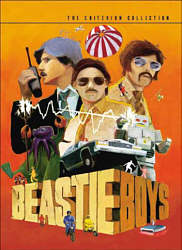
From DEPARTMENT OF THE NAVY -- NAVAL HISTORICAL CENTER: Brass Monkey



Please FREEPMAIL me if you want on, off, or alter the "Gods, Graves, Glyphs" PING list --
Archaeology/Anthropology/Ancient Cultures/Artifacts/Antiquities, etc.
The GGG Digest -- Gods, Graves, Glyphs (alpha order)
FACT:
Brass Monkey Lyrics
Artist: Beastie Boys
Album: Licensed To Ill
(chorus) Brass Monkey - that funky Monkey
Brass Monkey - junkie
That funky Monkey
Got this dance that's more than real
Drink Brass Monkey - here's how you feel
Put your left leg down - your right leg up
Tilt your head back - let's finish the cup
M.C.A. with the bottle - D. rocks the can
Adrock gets nice with Charlie Chan
We're offered Moet - we don't mind Chivas
Wherever we go with bring the Monkey with us
Adrock drinks three - Mike D. is D.
Double R. foots the bill most definitely
I drink Brass Monkey and I rock well
I got a Castle in Brooklyn - that's where I dwell
(repeat chorus)
{snip}
(repeat chorus)
I've known this one for years... Funny as heck, too!
"As near as the Cap'n can figure, the original saying was 'freeze the TAIL off a brass monkey'.
A brass monkey was a small cannon with a brass barrel mounted on an upper deck.
A monkey tail was an iron handspike used to aim the cannon.
Iron becomes brittle at low temperatures.
So when you're trying to aim this cannon in the roaring 40's you're likely to break the tail off on the brass monkey."
Personal note: These smaller cannon would cool off much quicker than the larger ones, as well.. resulting in more temperature stress on the metal. ( metal fatigue? )
Rapid heating and cooling in cold weather engagements could result in the "tail" of the "brass monkey" cracking or breaking off..
"And before you sea lawyers fire off a broadside at the old Cap'n, the Cap'n wants to point out that the difference between the thermal coefficient of linear expansion of brass and iron is about .000006 inch per degree C..
If you went from boiling to freezing with a yard of each metal you'd only have about 2 hundredths of an inch difference. And it's pretty well documented that the shot was held on deck in shot garlands and wooden racks, not in pyramids.
The above source would seem to be the most correct..
Other sources I checked often referenced the "freeze the tail" idiom, as well as other parts..
One source suggested that the saying means exactly what it says, but was later "cleaned up" with use of tail, nose, toes, etc.. but the original saying persisted..
Further, that some innovative "wordologist" invented an explanation that would give the saying "innocent" origins..
Another source I ran across claimed that the "brass monkey" was not a "base plate" onboard, but a portable brass powder keg taken on landings ashore, for small cannon. A replacement for the "powder monkey" that brought gunpowder from the ship's magazine to the cannoneers....
In this explanation, cannon ball were stacked around the "brass monkey" and cold weather would cause the shot to contract and collapse..
Another explanation had the brass base plate, but placed it's use in land warfare, specifically, during the Civil War..
There are almost as many references to the Civil War origins as there are the Naval origins..
Cursory examination of a number of period illustrations of sailing ships shows no such device as described..
It would appear that cannonball were kept below decks or in off-deck storage bins...
Logic demands they be kept below decks as far as possible, used as ballast until such time as they were actually needed in combat..
The decks were swept (and kept) clean of anything that could slide, roll, tumble, etc.. and cannon were lashed down when not actually in use..
